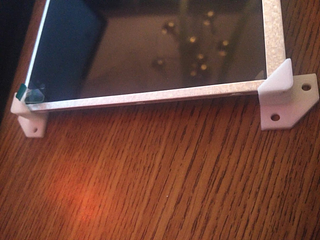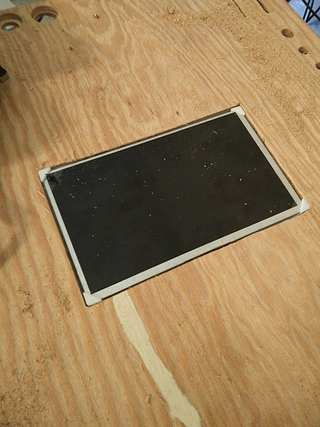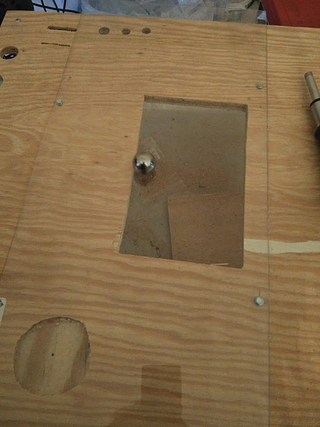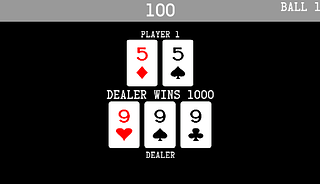3D printed some brackets for the screen. It's funny, prior to getting a 3D printer "how do I mount a screen under the playfield?" was a really big question mark on my project's todo list. With a 3D printer, I had it mounted just fine with 5 minutes of modeling. 
Made a test screen hole in my testing playfield plywood. Messed up the cut spectacularly somehow, my whole rectangle was like 1/4" skewed. Not sure how I managed that when I made it by tracing the screen, but oh well. 
I also tried mounting a test piece of 1/16" lexan over the hole, to see how much it deformed. I screwed it in at the same positions that the nearest posts are on the real playfield, to get an idea of how well it'd be held down. I had problems instantly with a bit of warping, since my holes weren't placed perfectly.
I think that to use this on a real playfield I'd need to pre-drill all the screw holes with a slightly larger bit, so it has some room to slide around while I'm tightening everything down. Then I'd have to work from the center outwards as I attached everything to try to keep it taut. 
My initial test of 'pressing it down with a finger' didn't seem very promising. I could flex the hole down way more than I can on my Black Hole. I still don't understand how the super thin window on black hole is so sturdy when every plastic I've looked at is so much more flexible...
In the end though, I realized I shouldn't be testing with my finger, but with a ball. Setting a ball in the middle of the hole has almost no effect on it, and it seems to roll across it fine. At worse, I can always make a second layer of plastic just for the screen, to bridge that section if it becomes an issue, so this approach still seems viable.
Another benefit I thought of is that I could conceivably mount my magnets way closer to the ball. With wood on top of the magnet, it seems like most playfields are still retaining 1/2-3/4 of their thickness to keep the wood solid, which means the magnet is probably about 3/16" away from the ball in the best case. With a plastic covering, I should be able to cut that down, which should make the magnet stronger, and might help with my issues on the upper magnet. I'm not very familiar with the physics of magnets though... I'm curious how this would compare to the large metal cores on games like TWD. Is a 3/16 thick, 3" wide metal core on top of a magnet generating a larger field than the entire winding itself does?
Next I need to figure out if I can use my star rollovers with it. I used them a lot in the design since they're easy to cut the holes for (compared to a rollover switch slot), but I know I've heard about issues with them and playfield protectors...










